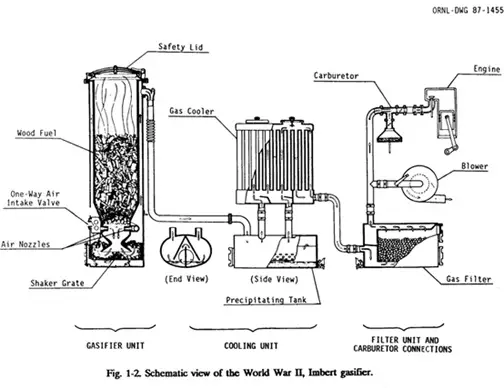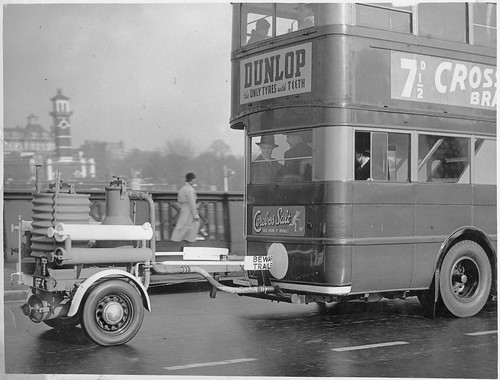Wood Gas Cars.
If Climate change were real and the IPCC were truly about saving the world then maybe they would grab something that works and make it better.Wood gas works. Its old technology. Its zero carbon. Its free fuel in some cases, cheap fuel in the city. It can be improved.
http://www.driveonwood.com/
http://en.wikipedia.org/wiki/Wood_gas_generator
http://www.motherearthnews.com/Green-Transportation/1981-05-01/Wood-Gas-Truck.aspx
Its worked before: WW2
http://www.youtube.com/watch?v=9ycJE7KgO60
It works now: http://www.youtube.com/watch?v=rHjUJPeUh7A
Its loose in Australia: http://www.gasificationaustralia.com/
An old site: http://www.angelfire.com/ak5/energy21/woodfire.htm
There is a hundred video's on youtube alone.
So why is this an ignored solution? Why has it not been optimised using all the resources of government and a thousand universities?
The answer is when they say their pulling out all the stops, trying everything, doing whatever is possible! Their not quite lying but its close! They can't even know that they are wrong.
Governments try to pick winners but the process automatically excludes those that don't call for help or subsidies. This technology needs no subsidies. That makes them invisible to government. Also because those that are invisible to government compete with those getting the subsidies the solutions that work become blocked by the ones that don't quite work. We get technology that needs government help and subsidies and thus can never truly be THE Solution.
So how do you optimise and improve such a technology.
- Hybridise for city use: Add 40 km of lithium batteries, that's not expensive or heavy. Add all electric drive and regenerative breaking.
- Add an optimised 1/4 size gasifier and filter with a small motor optimized to charge as you go. Use an automated blow torch ignition system for the pyrolysis system and computer control. Design the car around the gasifier with a rear engine, gasifier and filter. A rear camera to eliminate the blind spot. Put a baggage compartment in the front.
- I would try a fluidised bed sand filter on the hot gases. In a fluidised bed filter gas flows up through sand. The hot sand catches and cracks tars and ash into light combustibles. The sand also flows and can be made to flow past a heat exchanger to dissipate heat.
- Some WW2 models used water spray filters to wash and cool the gas. That also converts some of the carbon monoxide, the main fuel in wood gas, into hydrogen.
- For optimal no fuss shop bought fuel. Pre pack the fuel in cylindrical pucks made of blocks cut to size and glued with proper spacing between two paper sheets with a sheet around the edge. Add a paper handle. Make each puck under 6 kg. At the petrol station converted to a multi-fuel depot add a raised platform, steps and a remote locked cage of fuel pucks.
- Invent a briquette machine that converts straw into pellets so it can run on grass in the plains and the savannah.
- I would also add a HHO system: an electrolysis cell making mixed oxygen and hydrogen. The hydrogen would bias the flame speed and timing back to normal allowing smaller engines. CO burns slower that petrol; hydrogen burns faster than petrol. The two should balance.
The first priority is the hybrid and the compact optimised power-plant. Everything else will follow as the technology optimises.
Less like this:
More like this:
I don't think governments can do this. I don't think they can even see real solutions. What's best for the voters is not best for the bureaucrats. Solve a real problem and you kill off a bureaucrats job.
The Earth First greens will automatically oppose this. To them Wood means the evils of forestry. Sustainable human intervention in nature is inconceivable. They will scream 'deforestation'! We must safe guard against that in some third world counties and government run forests, because they are the remaining commons on land. The "Tragedy of the commons" can only happen with government land, tribal lands and the seas. Private lands are not commons.
I don't think Anthropogenic Greenhouse effect is having any catastrophic effects on humanity or the biosphere. Change happens in all ecosystems and climate change is normal.
However if Peak Oil is real and solutions are needed. Wood gas as it is currently configured is a good fuel for those in naturally wooded country side. It can be free as the above sites show.
It requires skill; but so did all engines once.
It can provide stationary power.
http://gasifier.wpengine.com/personal-energy-grid
http://www.motherearthnews.com/Renewable-Energy/1981-07-01/Mothers-Backyard-Homestead-Utility.aspx
Can this be used on every car and tractor in the world? No but this will work where electric vehicles fail. Optimised it will put a big dent in any energy shortage.
Here are some Swedes having a go in 1942. Full factory production.
http://www.youtube.com/watch?v=vGO5J9HMkGE
(If someone can do subtitles that would be nice. One American wood gas enthusiast caries a small electric chainsaw in his car. I bet these swedes wish they had one.)
Edit: Fixed the dead links.





6 comments:
I researched this a few years ago when there seemed to be a panic about fuel supplies and there were a few people using it for out back use, trailer mounted. The WW11 buses had power problems up hills and I remember seeing passengers pushing a bus regularly up one hill.(Water Gas producer on trailer)
Charcoal seemed to be a better fuel, and I made a charcoal producer by placing a 12 gallon oil drum in a 44 gallon drum, horizontally, with bars to centralize the small drum. Chimney at one end of the 44, pack the 12gal with small hardwood sticks or logs up to 2"diam loosely fasten lid.
Pack all around with small twigs and sticks and light, when going well fasten lid (with hit and miss dial vent near base). Leave going overnight and the small drum will have converted contents to charcoal. Haven't got round to making the gas producer yet though!
During WW2 we had a sawmill and two 'charcoal burner' vehicles and burned our own charcoal in two pits of about 15 cubic metres each. One vehicle was a utility and the other a 5 ton truck.
Problems were: Low power. On the way out to cut logs, the 5 tonner was towed up a mountain by a 1 ton petrol driven Chev. It took one 'potato' sack of charcoal to drive 100Km in the ute, so on a long trip we carried quite a few sacks in the back.
The ute was home made with a water filter but the truck had a box of feather dusters as a filter and by the end of the war, the engine was worn out from ash getting into the engine. They both suffered excessive valve wear from the absence of lead as a lubricant.
I guess 2012 technology will have improved all that, but I can't see it being an alternative to hydrogen/fuel cell vehicles, with the H2 generated by electrolysis as now available in California and rolling out in Israel.
But, breakthroughs happen and the impossible becomes the possible.
One thing is sure, gasoline was a wonderful fuel but there ain't much left.
During WW2 we had a sawmill and two 'charcoal burner' vehicles and burned our own charcoal in two pits of about 15 cubic metres each. One vehicle was a utility and the other a 5 ton truck.
Problems were: Low power. On the way out to cut logs, the 5 tonner was towed up a mountain by a 1 ton petrol driven Chev. It took one 'potato' sack of charcoal to drive 100Km in the ute, so on a long trip we carried quite a few sacks in the back.
The ute was home made with a water filter but the truck had a box of feather dusters as a filter and by the end of the war, the engine was worn out from ash getting into the engine. They both suffered excessive valve wear from the absence of lead as a lubricant.
I guess 2012 technology will have improved all that, but I can't see it being an alternative to hydrogen/fuel cell vehicles, with the H2 generated by electrolysis as now available in California and rolling out in Israel.
But, breakthroughs happen and the impossible becomes the possible.
One thing is sure, gasoline was a wonderful fuel but there ain't much left.
Sorry about the double up, but I came back to say I watched several of the wood burner videos and can say the wood burners (walnut shells, garbage) are much easier to DIY than the charcoal burners I remember. Cutting out the charcoal manufacture phase also allows the capture of the lighter gases, H2 and methane! All the units viewed were a bit clunky, but if research is applied that is anywhere near what goes into petrol/diesel technology, it should develop to being used widely. I note they all used blowers to get going but the old units started on petrol and the motor suction got the charcoal burning then the petrol was turned off and away it went on charcoal gas. Methanol or ethanol of course could be used in the start-up.
Good stuff mate!
Thanks gentlemen.
I'm afraid I'm going to have to correct something. While wood gas provides an alternative to fossil fuels it is by no means a zero carbon energy source.
While it is true that most of the energy you get by burning wood gas comes from burning hydrogen, there's actually quite a lot of carbon mixed in. According to wikipedia, wood gas is 27% carbon monoxide (CO), 4.5% carbon dioxide (CO2) and 3.0% methane (CH4). Burning a kilogram of wood gas also gives a lot less energy(5.7 MJ/kg) than burning a kilogram of gasoline (44.1 MJ/kg).
I did some calculations based on that data and found that to produce the same amount of energy, burning wood gas produces approximately 40% more CO2 than gasoline.
That's not even counting possible CO2 emissions from the production of wood gas, or the energy loss of running an engine with a significantly less powerful fuel than what it was designed for. Granted, these two areas have room for improvement, but even at theoretical optimums it can't compete with gasoline.
Post a Comment